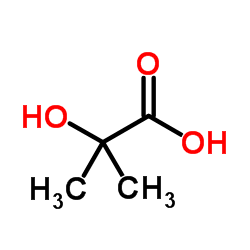2-Hydroxyisobutyric acid

2-Hydroxyisobutyric acid structure
|
Common Name | 2-Hydroxyisobutyric acid | ||
|---|---|---|---|---|
| CAS Number | 594-61-6 | Molecular Weight | 104.104 | |
| Density | 1.2±0.1 g/cm3 | Boiling Point | 212.0±0.0 °C at 760 mmHg | |
| Molecular Formula | C4H8O3 | Melting Point | 76-80 °C(lit.) | |
| MSDS | Chinese USA | Flash Point | 104.9±16.3 °C | |
| Symbol |


GHS05, GHS07 |
Signal Word | Danger | |
|
Thermophilic Coenzyme B12-Dependent Acyl Coenzyme A (CoA) Mutase from Kyrpidia tusciae DSM 2912 Preferentially Catalyzes Isomerization of (R)-3-Hydroxybutyryl-CoA and 2-Hydroxyisobutyryl-CoA.
Appl. Environ. Microbiol. 81 , 4564-72, (2015) The recent discovery of a coenzyme B12-dependent acyl-coenzyme A (acyl-CoA) mutase isomerizing 3-hydroxybutyryl- and 2-hydroxyisobutyryl-CoA in the mesophilic bacterium Aquincola tertiaricarbonis L108 (N. Yaneva, J. Schuster, F. Schäfer, V. Lede, D. Przybylsk... |
|
|
Capillary electrophoresis of small ions using complex formation and indirect detection.
Electrophoresis 30 Suppl 1 , S34-9, (2009) The journal Electrophoresis was launched in about the same time as modern CE. Today, Electrophoresis is one of the leading journals in the field of analytical separations. With over 23% of all papers on CE published in the past 5 years Electrophoresis is also... |
|
|
Solid-state and solution-state coordination chemistry of lanthanide(III) complexes with α-hydroxyisobutyric acid.
Inorg. Chem. 51(24) , 13254-63, (2012) Despite the wide range of applications of α-hydroxyisobutyric acid (HIBA) in biochemical processes, pharmaceutical formulations, and group and elemental separations of lanthanides and actinides, the structures and geometries of lanthanide-HIBA complexes are s... |
|
|
Enhancement of hydroxyl radical generation in the Fenton reaction by alpha-hydroxy acid.
Biochem. Mol. Biol. Int. 46(1) , 137-45, (1998) The effect of various organic acids on hydroxyl radical (.OH) generation in the Fenton reaction were examined by the ESR spin trapping technique, where 5,5-dimethyl-1-pyroline-N-nitroxide (DMPO) and alpha-phenyl-tert-butyl nitrone (PBN) were used as the spin ... |
|
|
Computer optimization of background electrolyte composition in the separation of metal ions by capillary electrophoresis.
Electrophoresis 17(8) , 1367-72, (1996) The iterative regression design developed earlier for high performance liquid chromatography (HPLC) has been applied successfully to the optimization of the separation of 11 metal ions by capillary electrophoresis. The parameters used for optimization were pH... |
|
|
Determination of six metals in galician red wines (in northwestern Spain) by capillary electrophoresis.
J. AOAC Int. 83(1) , 183-8, (2000) A simple technique is described for the routine simultaneous capillary electrophoretic determination of 6 cations in wine. Separation was achieved on a fused silica capillary column with a UV-Cat-1, alpha-hydroxysobutyric acid and 18-crown-6-ether buffer at p... |
|
|
Improved GC-MS procedure for simultaneous measurement of ethylene glycol and glycolic acid.
Clin. Chem. 56(12) , 1900-2, (2010)
|
|
|
Arg-425 of the citrate transporter CitP is responsible for high affinity binding of di- and tricarboxylates.
J. Biol. Chem. 275(50) , 39130-6, (2000) The citrate transporter of Leuconostoc mesenteroides (CitP) catalyzes exchange of divalent anionic citrate from the medium for monovalent anionic lactate, which is an end product of citrate degradation. The exchange generates a membrane potential and thus met... |
|
|
Physiology and pathophysiology of organic acids in cerebrospinal fluid.
J. Inherit. Metab. Dis. 16(4) , 648-69, (1993) Concentrations of organic acids in cerebrospinal fluid (CSF) appear to be directly dependent upon their rate of production in the brain. There is evidence that the net release of short-chain monocarboxylic acids from the brain is a major route for removing th... |
|
|
The alkyl tert-butyl ether intermediate 2-hydroxyisobutyrate is degraded via a novel cobalamin-dependent mutase pathway.
Appl. Environ. Microbiol. 72(6) , 4128-35, (2006) Fuel oxygenates such as methyl and ethyl tert-butyl ether (MTBE and ETBE, respectively) are degraded only by a limited number of bacterial strains. The aerobic pathway is generally thought to run via tert-butyl alcohol (TBA) and 2-hydroxyisobutyrate (2-HIBA),... |